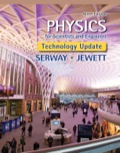
Review. A global positioning system (GPS) satellite moves in a circular orbit with period 11 h 58 min. (a) Determine the radius of its orbit. (b) Determine its speed. (c) The nonmilitary GPS signal is broadcast at a frequency of 1 575.42 MHz in the reference frame of the satellite. When it is received on the Earth’s surface by a GPS receiver (Fig. P38.41), what is the fractional change in this frequency due to time dilation as described by
where Ug is the change in gravitational potential energy of an object–Earth system when the object of mass m is moved between the two points where the signal is observed. Calculate this fractional change in frequency due to the change in position of the satellite from the Earth’s surface to its orbital position. (e) What is the overall fractional change in frequency due to both time dilation and gravitational blueshift?
Figure P38.41

(a)
Answer to Problem 39.65P
Explanation of Solution
Given info: The time period of the satellite moving around earth in the circular orbit is
The value of force of gravitational constant
The mass of earth is
Explanation:
From Newton’s second law, the nature of the force between the earth and satellite system is the gravitational force between the earth and the satellite and the centripetal force between them. Both the forces should be equal so that the satellite can revolve in an orbit.
The formula to calculate gravitational force is
Here,
The speed of the satellite is
Here,
The time period of the satellite is,
The formula to calculate the centripetal force is
Here,
Substitute
Equate equation (1) and (2)
Substitute
Thus the radius of the orbit of the satellite is
Conclusion:
Therefore, the radius of the orbit of the GPS satellite in which ir revolves around the earth is
(b)
Answer to Problem 39.65P
Explanation of Solution
Explanation
The formula to calculate the speed of the satellite revolving around the earth in a circular orbit is,
Substitute
Thus the speed of the satellite is
Conclusion:
Therefore, speed of the satellite revolving around the earth in a circular orbit is
(c)
Answer to Problem 39.65P
Explanation of Solution
Explanation
Given info: The broadcast signal frequency of the GPS satellite is
The formula to calculate the frequency of any signal is,
Here,
Differentiate the above equation.
Thus, the fractional change in the frequency is the equal to fractional change in the time period.
The formula to calculate the fractional increase in time period is,
Here,
The formula to calculate the relativistic factor is,
Here,
Substitute
Substitute
Take the Binomial expansion series expansion of the term
Substitute
Thus the fractional change in frequency is
Conclusion:
Therefore, fractional change in the received frequency is
(d)
Answer to Problem 39.65P
Explanation of Solution
Explanation
The formula to calculate the gravitational blue shift is,
Here,
The formula to calculate the gravitational potential energy between the earth’s surface and the satellite orbit is
Here,
Substitute
Substitute
Substitute
Thus the fractional change in frequency due to the gravitational blue shift is
Conclusion:
Therefore, fractional change in frequency due to the gravitational blue shift is
(e)
Answer to Problem 39.65P
Explanation of Solution
Explanation
The overall fractional change in the frequency is the sum of the both the fractional changes.
Thus the overall fractional change is the sum of the fractional change in the frequency due to the time dilation and fractional change in the frequency due to the gravitational blue shift.
The formula to calculate the overall fractional change is,
 Overall fractional change =
Overall fractional change =
Substitute
Conclusion:
Therefore, the overall fractional change in the frequency is
Want to see more full solutions like this?
Chapter 39 Solutions
EBK PHYSICS FOR SCIENTISTS AND ENGINEER
- Use the following information to answer the next two questions. A laser is directed at a prism made of zircon (n = 1.92) at an incident angle of 35.0°, as shown in the diagram. 3a) Determine the critical angle of zircon. 35.0° 70° 55 55° 3b) Determine the angle of refraction when the laser beam leaves the prism.arrow_forwardNo chatgpt pls will upvotearrow_forwardA beam of alpha-particles of energy 7.3MeV is used.The protons emitted at an angle of zero degree are found to have energy of 9.34MeV.Find the Q-value of this reaction .arrow_forward
- An aluminum rod and a copper rod have the same length of 100cm at 5C. At what temperatures would one of the rods be 0.5 mm longer than the other? Which rod is longer at such temperature?arrow_forwardROTATIONAL DYNAMICS Question 01 A solid circular cylinder and a solid spherical ball of the same mass and radius are rolling together down the same inclined. Calculate the ratio of their kinetic energy. Assume pure rolling motion Question 02 A sphere and cylinder of the same mass and radius start from ret at the same point and more down the same plane inclined at 30° to the horizontal Which body gets the bottom first and what is its acceleration b) What angle of inclination of the plane is needed to give the slower body the same acceleration Question 03 i) Define the angular velocity of a rotating body and give its SI unit A car wheel has its angular velocity changing from 2rads to 30 rads seconds. If the radius of the wheel is 400mm. calculate ii) The angular acceleration iii) The tangential linear acceleration of a point on the rim of the wheel Question 04 in 20arrow_forwardQuestion B3 Consider the following FLRW spacetime: t2 ds² = -dt² + (dx² + dy²+ dz²), t2 where t is a constant. a) State whether this universe is spatially open, closed or flat. [2 marks] b) Determine the Hubble factor H(t), and represent it in a (roughly drawn) plot as a function of time t, starting at t = 0. [3 marks] c) Taking galaxy A to be located at (x, y, z) = (0,0,0), determine the proper distance to galaxy B located at (x, y, z) = (L, 0, 0). Determine the recessional velocity of galaxy B with respect to galaxy A. d) The Friedmann equations are 2 k 8πG а 4πG + a² (p+3p). 3 a 3 [5 marks] Use these equations to determine the energy density p(t) and the pressure p(t) for the FLRW spacetime specified at the top of the page. [5 marks] e) Given the result of question B3.d, state whether the FLRW universe in question is (i) radiation-dominated, (ii) matter-dominated, (iii) cosmological-constant-dominated, or (iv) none of the previous. Justify your answer. f) [5 marks] A conformally…arrow_forward
- SECTION B Answer ONLY TWO questions in Section B [Expect to use one single-sided A4 page for each Section-B sub question.] Question B1 Consider the line element where w is a constant. ds²=-dt²+e2wt dx², a) Determine the components of the metric and of the inverse metric. [2 marks] b) Determine the Christoffel symbols. [See the Appendix of this document.] [10 marks] c) Write down the geodesic equations. [5 marks] d) Show that e2wt it is a constant of geodesic motion. [4 marks] e) Solve the geodesic equations for null geodesics. [4 marks]arrow_forwardPage 2 SECTION A Answer ALL questions in Section A [Expect to use one single-sided A4 page for each Section-A sub question.] Question A1 SPA6308 (2024) Consider Minkowski spacetime in Cartesian coordinates th = (t, x, y, z), such that ds² = dt² + dx² + dy² + dz². (a) Consider the vector with components V" = (1,-1,0,0). Determine V and V. V. (b) Consider now the coordinate system x' (u, v, y, z) such that u =t-x, v=t+x. [2 marks] Write down the line element, the metric, the Christoffel symbols and the Riemann curvature tensor in the new coordinates. [See the Appendix of this document.] [5 marks] (c) Determine V", that is, write the object in question A1.a in the coordinate system x'. Verify explicitly that V. V is invariant under the coordinate transformation. Question A2 [5 marks] Suppose that A, is a covector field, and consider the object Fv=AAμ. (a) Show explicitly that F is a tensor, that is, show that it transforms appropriately under a coordinate transformation. [5 marks] (b)…arrow_forwardHow does boiling point of water decreases as the altitude increases?arrow_forward
 Physics for Scientists and Engineers with Modern ...PhysicsISBN:9781337553292Author:Raymond A. Serway, John W. JewettPublisher:Cengage Learning
Physics for Scientists and Engineers with Modern ...PhysicsISBN:9781337553292Author:Raymond A. Serway, John W. JewettPublisher:Cengage Learning Physics for Scientists and EngineersPhysicsISBN:9781337553278Author:Raymond A. Serway, John W. JewettPublisher:Cengage Learning
Physics for Scientists and EngineersPhysicsISBN:9781337553278Author:Raymond A. Serway, John W. JewettPublisher:Cengage Learning Principles of Physics: A Calculus-Based TextPhysicsISBN:9781133104261Author:Raymond A. Serway, John W. JewettPublisher:Cengage Learning
Principles of Physics: A Calculus-Based TextPhysicsISBN:9781133104261Author:Raymond A. Serway, John W. JewettPublisher:Cengage Learning Physics for Scientists and Engineers: Foundations...PhysicsISBN:9781133939146Author:Katz, Debora M.Publisher:Cengage Learning
Physics for Scientists and Engineers: Foundations...PhysicsISBN:9781133939146Author:Katz, Debora M.Publisher:Cengage Learning Modern PhysicsPhysicsISBN:9781111794378Author:Raymond A. Serway, Clement J. Moses, Curt A. MoyerPublisher:Cengage Learning
Modern PhysicsPhysicsISBN:9781111794378Author:Raymond A. Serway, Clement J. Moses, Curt A. MoyerPublisher:Cengage Learning Physics for Scientists and Engineers, Technology ...PhysicsISBN:9781305116399Author:Raymond A. Serway, John W. JewettPublisher:Cengage Learning
Physics for Scientists and Engineers, Technology ...PhysicsISBN:9781305116399Author:Raymond A. Serway, John W. JewettPublisher:Cengage Learning





